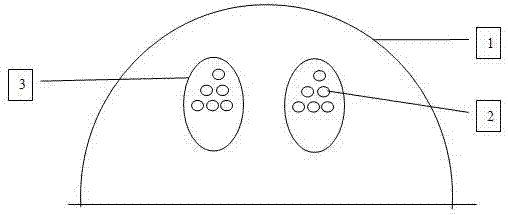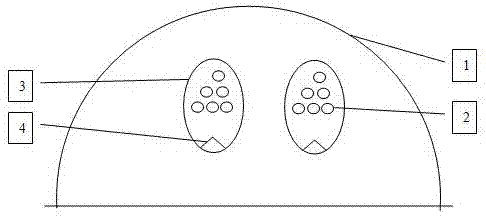Tent capable of reducing wind influence and sun-shading shed and rainshed capable of ventilating
A tent and tarpaulin technology, applied in the field of awnings and rain sheds, can solve the problem of tents that are not easy to use
- Summary
- Abstract
- Description
- Claims
- Application Information
AI Technical Summary
Problems solved by technology
Method used
Image
Examples
Embodiment 1
[0016] A tent that reduces the impact of wind (close to cover)
[0017] There are many ventilation holes 2 on the tarpaulin 1, and a cover blade 3 corresponds to cover a group of ventilation holes 2. In the windless state, the cover blade 3 naturally droops to cover the corresponding group of ventilation holes 2. When the wind is greater than 3 levels, the blades are covered 3 is automatically blown by the wind, and the wind can pass through the air hole 2, thereby reducing the impact on the tent. At the same time, because the cover blade 3 is obviously larger than the air hole 2 and cannot pass through, the cover blade 3 can be automatically reset when there is no wind or the wind is small. Covering the corresponding set of vent holes 2.
Embodiment 2
[0019] A tent that reduces the impact of wind (not close to cover)
[0020] There are many air holes 2 on the tarpaulin 1, and one cover blade 3 corresponds to cover a group of air holes 2. In the windless state, the cover blade 3 naturally droops to cover the corresponding group of air holes 2. There is still an obvious gap between the blade and the tarpaulin under the support. When there is wind, the wind can pass through the air hole 2 automatically, thereby reducing the impact on the tent. Because there is a connection to the support frame 4 to cover the blade 3, it will not be released. One group of air holes 2 is covered, and at the same time, because the cover blade 3 is obviously larger than the air holes 2, it cannot pass through the covering of the corresponding group of air holes 3 all the time.
PUM
 Login to View More
Login to View More Abstract
Description
Claims
Application Information
 Login to View More
Login to View More - R&D
- Intellectual Property
- Life Sciences
- Materials
- Tech Scout
- Unparalleled Data Quality
- Higher Quality Content
- 60% Fewer Hallucinations
Browse by: Latest US Patents, China's latest patents, Technical Efficacy Thesaurus, Application Domain, Technology Topic, Popular Technical Reports.
© 2025 PatSnap. All rights reserved.Legal|Privacy policy|Modern Slavery Act Transparency Statement|Sitemap|About US| Contact US: help@patsnap.com


